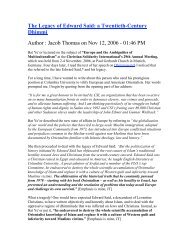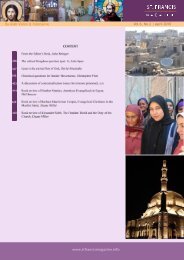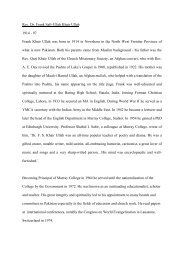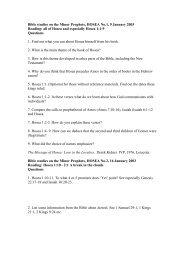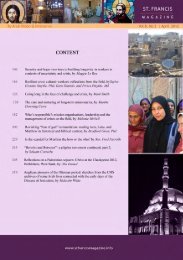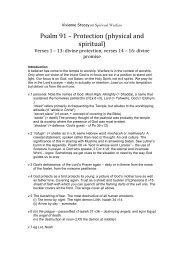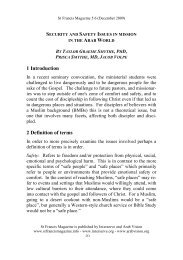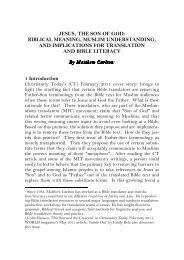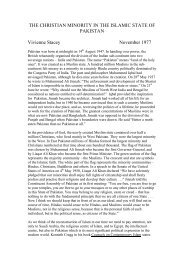what are the advantages of church planting movements over against ...
what are the advantages of church planting movements over against ...
what are the advantages of church planting movements over against ...
You also want an ePaper? Increase the reach of your titles
YUMPU automatically turns print PDFs into web optimized ePapers that Google loves.
St Francis Magazine Vol 6, No 6 | December 2010<br />
WHAT ARE THE ADVANTAGES OF<br />
CHURCH PLANTING MOVEMENTS OVER AGAINST<br />
INSIDER MOVEMENTS?<br />
1 Introduction<br />
By Chris Flint 1<br />
Since <strong>the</strong> late 20 th century, Church Planting Movements (CPM) and<br />
Insider Movements (IM) have been observed by missionaries around<br />
<strong>the</strong> world. Many missiologists believe <strong>the</strong>se <strong>movements</strong> to be s<strong>over</strong>eign<br />
works <strong>of</strong> God, and advocate strategies to facilitate <strong>the</strong>ir extension<br />
so that more Christians might align <strong>the</strong>mselves “with <strong>the</strong> ways<br />
God has chosen to work.” 2<br />
This paper begins from <strong>the</strong> premise that <strong>the</strong> Bible alone is God’s<br />
complete, au<strong>the</strong>nticated and authoritative revelation to humanity, and<br />
thus <strong>the</strong>se <strong>movements</strong> must be evaluated biblically before Christians<br />
<strong>are</strong> enjoined upon to support <strong>the</strong>m. To this end, CPMs and IMs will<br />
be described, and <strong>the</strong> <strong>advantages</strong> <strong>of</strong> CPMs <strong>over</strong> IMs identified. 3<br />
It shall be seen that <strong>the</strong> two <strong>movements</strong> sh<strong>are</strong> potential for considerable<br />
<strong>over</strong>lap. In many <strong>are</strong>as, <strong>the</strong>refore, distinctions <strong>are</strong> blurred<br />
and comparison becomes difficult. Their approaches to o<strong>the</strong>r religions,<br />
however, <strong>are</strong> sharply contrastive and, at this definitive juncture,<br />
it is submitted, CPMs take <strong>the</strong> more biblical path.<br />
1<br />
Chris Flint has had two years' experience <strong>of</strong> Christian ministry in a Muslimmajority<br />
country, and is now studying for an MTh in 'Theology and World Mission'<br />
at Oak Hill Theological College, London.<br />
2 David and Seneca Garrison, ‘Factors That Facilitate Fellowships Becoming Movements’,<br />
in J. Dudley Woodberry Ed), From Seed to Fruit: Global Trends, Fruitful<br />
Practices, and Emerging Issues among Muslims (Pasadena, Calif.: William C<strong>are</strong>y<br />
Library, 2008), p. 207. Emphasis original.<br />
3 In line with <strong>the</strong> premise <strong>of</strong> this paper, an “advantage” is here understood as shorthand<br />
for “a demonstrated coherence with biblical teaching.” The observations<br />
which missiologists describe <strong>are</strong> no less open to biblical evaluation than <strong>are</strong> <strong>the</strong> strategies<br />
which missiologists prescribe on <strong>the</strong> basis <strong>of</strong> <strong>the</strong>m.<br />
890<br />
St Francis Magazine is published by Interserve and Arab Vision
St Francis Magazine Vol 6, No 6 | December 2010<br />
2 Church Planting Movements<br />
2.1 Dr David Garrison<br />
Dr. David Garrison is a significant proponent <strong>of</strong> CPMs. In his widely<br />
translated booklet, he writes:<br />
God has shown us that He is indeed doing something in our days among<br />
<strong>the</strong> peoples <strong>of</strong> <strong>the</strong> earth – something so amazing we would not have believed<br />
it had we not seen it with our own eyes (see Hab. 1:5). We <strong>are</strong><br />
calling this amazing thing Church Planting Movements. 4<br />
Garrison has subsequently written a book, 5 and launched a website,<br />
6 to propagate CPMs worldwide. It is with his presentation <strong>of</strong><br />
CPMs that this paper will interact.<br />
2.2 Definitions<br />
Garrison defines a CPM as “a rapid multiplication <strong>of</strong> indigenous<br />
<strong>church</strong>es <strong>planting</strong> <strong>church</strong>es that sweeps through a people group or<br />
population segment.” 7 In this definition<br />
Rapid signifies “[f]aster than you think possible,” 8 and “always <br />
outstrip[ping] <strong>the</strong> population growth rate.” 9 <br />
Multiplication, as opposed to mere addition, describes how <br />
“virtually every <strong>church</strong> is engaged in starting multiple new <br />
<strong>church</strong>es.” 10 <br />
4 David Garrison, Church Planting Movements (Richmond, Va: IMB, 1999), p. 47.<br />
5 David Garrison, Church Planting Movements: How God is Redeeming a Lost<br />
World (Midlothian, Va.: WIGTake Resources, 2004).<br />
6 David Garrison, ‘Church Planting Movements: Best Practices from Across <strong>the</strong><br />
Globe’, see www.<strong>church</strong><strong>planting</strong><strong>movements</strong>.com (28 Oct 2010).<br />
7 Garrison, Church Planting Movements, 21.<br />
8 Ibid.<br />
9 Ibid., p. 22.<br />
10 Ibid.<br />
891<br />
St Francis Magazine is published by Interserve and Arab Vision
St Francis Magazine Vol 6, No 6 | December 2010<br />
Indigenous means “generated from within, as opposed to star-ted<br />
by outsiders.” 11<br />
Churches <strong>planting</strong> <strong>church</strong>es occurs when <strong>the</strong> “tipping point” is<br />
passed, 12 and “<strong>the</strong> momentum <strong>of</strong> reproducing <strong>church</strong>es outstrips<br />
<strong>the</strong> ability <strong>of</strong> <strong>the</strong> planters to control it. ”13<br />
People groups or population segments refer to <strong>the</strong> “sh<strong>are</strong>d language<br />
and ethnic boundaries” within which “communication <strong>of</strong><br />
<strong>the</strong> gospel message … naturally occur[s].” 14<br />
2.3 Description <strong>of</strong> CPMs<br />
Garrison describes ten characteristics common to all CPMs:<br />
2.3.1 Extraordinary Prayer<br />
A strong aw<strong>are</strong>ness <strong>of</strong> <strong>the</strong> spiritual dimension makes prayer “<strong>the</strong> first<br />
priority <strong>of</strong> every Church Planting Movement strategist.” 15 Intercession<br />
is made for <strong>the</strong> lost people group, for new believers and unbelievers,<br />
for more workers, for and between <strong>the</strong> missionaries, and for<br />
and by <strong>the</strong> new believers. 16 The missionary’s responsibility to model<br />
prayer is emphasised. 17<br />
2.3.2 Abundant Evangelism<br />
The “principle <strong>of</strong> <strong>over</strong>-sowing” is “essential” to every CPM. 18 In<br />
contrast to <strong>what</strong> Garrison calls <strong>the</strong> “traditional model,” in which<br />
Christians seek to build friendships before sharing <strong>the</strong> gospel, CPMs<br />
see “hundreds and thousands <strong>of</strong> people hearing <strong>the</strong> gospel every<br />
day.” 19 “Effective communication,” more<strong>over</strong>, “requires understan-<br />
11 Ibid.<br />
12 Ibid.<br />
13 Ibid., p. 23.<br />
14 Ibid.<br />
15 Ibid., 173.<br />
16 Ibid., pp. 173-76.<br />
17 Ibid., p. 175.<br />
18 Ibid., p. 177.<br />
19 Ibid.<br />
892<br />
St Francis Magazine is published by Interserve and Arab Vision
St Francis Magazine Vol 6, No 6 | December 2010<br />
ding <strong>the</strong> language and worldview <strong>of</strong> <strong>the</strong> people you <strong>are</strong> trying to<br />
reach.” 20 “[T]he primary evangelizers <strong>are</strong> always <strong>the</strong> new believers<br />
<strong>the</strong>mselves,” who “contextualise <strong>the</strong> gospel better than anyone.” 21<br />
2.3.3 Intentional Planting <strong>of</strong> Reproducing Churches<br />
The aim is not merely to plant <strong>church</strong>es, but “to plant reproducing<br />
<strong>church</strong>es.” 22 “If a fellowship is to be reproduced, <strong>the</strong>n it must be<br />
both reproducible and reproducing.” 23 To this end, “[a]ll <strong>the</strong> elements<br />
that <strong>are</strong> foreign to <strong>the</strong> <strong>church</strong> – and not easily reproduced –<br />
[<strong>are</strong>] eliminated. ”24<br />
2.3.4 The Authority <strong>of</strong> God’s Word<br />
The missionary must demonstrate that it is <strong>the</strong> Bible which is “authoritative<br />
for <strong>the</strong> new believers and <strong>the</strong> emerging <strong>church</strong>, not <strong>the</strong> wisdom<br />
<strong>of</strong> <strong>the</strong> missionary nor some foreign creed nor even <strong>the</strong> local<br />
<strong>church</strong> authorities.” 25 Where <strong>the</strong> populace is illiterate, “Memorization,”<br />
26 “Audio-visual,” 27 “Bible Storying,” 28 “Songs,” 29 and “Using<br />
Educated Youth,” 30 <strong>are</strong> strategies employed for communicating<br />
God’s word.<br />
20 Ibid., p. 179.<br />
21 Ibid., p. 181. Cf. “For outsiders, contextualization can help. Insiders will contextualize<br />
more naturally, particularly if <strong>the</strong>y have recently turned in faith to Jesus.”<br />
Garrison and Garrison, ‘Factors That Facilitate Fellowships Becoming Movements’,<br />
p. 212.<br />
22 Garrison, Church Planting Movements, 181. Emphasis original.<br />
23 Garrison and Garrison, ‘Factors That Facilitate Fellowships Becoming Movements’,<br />
p. 216.<br />
24 Garrison, Church Planting Movements, p. 196.<br />
25 Ibid., p.183.<br />
26 Ibid., p. 184.<br />
27 Ibid., p. 184.<br />
28 Ibid., p. 184.<br />
29 Ibid., p. 185.<br />
30 Ibid., p. 185.<br />
893<br />
St Francis Magazine is published by Interserve and Arab Vision
St Francis Magazine Vol 6, No 6 | December 2010<br />
2.3.5 Local Leadership<br />
Unlike <strong>what</strong> Garrison calls <strong>the</strong> “colonial model” which “stays to rule<br />
<strong>over</strong> <strong>the</strong> conquered territory,” CPMs “[transfer] <strong>the</strong> responsibility,<br />
vision, and momentum to new Christians.” 31 While “outsiders” may<br />
have a “vital” role to play in <strong>the</strong> introductory stages, 32 CPMs do not<br />
“[rely] on <strong>the</strong> leadership <strong>of</strong> outsiders.” 33 Their “axiom” is: “The resources<br />
<strong>are</strong> in <strong>the</strong> harvest.” 34<br />
2.3.6 Lay Leadership<br />
In CPMs it is “<strong>the</strong> laity who <strong>are</strong> leading <strong>the</strong> way.” 35 Paid leaders<br />
would “have a disincentive to start new groups as this would tend to<br />
erode <strong>the</strong> financial basis for <strong>the</strong>ir own ministry.” 36 The impracticalities<br />
<strong>of</strong> sending part-time pastors for residential seminary education<br />
require “innovative ways to make <strong>the</strong>ological education available,”<br />
such as “distance learning.” 37 On-<strong>the</strong>-job leadership training is “vital.”<br />
38<br />
2.3.7 House Churches<br />
Churches meet in homes, not dedicated <strong>church</strong> buildings. 39 This<br />
keeps ga<strong>the</strong>rings “small enough … for a layperson to lead without<br />
leaving <strong>the</strong>ir secular employment.” 40 Departing from <strong>the</strong><br />
“[c]onventional wisdom … that one should always work through <strong>the</strong><br />
local <strong>church</strong>” is justified because “[i]n too many instances <strong>the</strong> local<br />
31 Ibid., p. 268.<br />
32 Ibid., p. 224.<br />
33 Ibid., p. 188.<br />
34 Ibid., p. 186.<br />
35 Ibid., p. 191.<br />
36 Garrison and Garrison, ‘Factors That Facilitate Fellowships Becoming Movements’,<br />
p. 216.<br />
37 Garrison, Church Planting Movements, 270.<br />
38 Ibid., p. 234.<br />
39 Ibid., p. 192.<br />
40 Ibid., p. 191. Emphasis original.<br />
894<br />
St Francis Magazine is published by Interserve and Arab Vision
St Francis Magazine Vol 6, No 6 | December 2010<br />
<strong>church</strong> is <strong>the</strong> major stumbling block that is preventing <strong>the</strong> unreached<br />
from coming to Christ.” 41<br />
2.3.8 Churches Planting Churches<br />
It is <strong>the</strong> role <strong>of</strong> <strong>the</strong> <strong>church</strong>es, not <strong>the</strong> missionaries, to plant new <strong>church</strong>es.<br />
Missionaries must relocate as soon as “<strong>the</strong>ir protégés” have<br />
begun “to effectively reproduce <strong>what</strong> <strong>the</strong>y have learned and experienced.”<br />
42 This conscious “bias toward new <strong>church</strong> starts <strong>over</strong><br />
<strong>against</strong> enlarging older works is in sharp contrast with conventional<br />
practice.” 43<br />
2.3.9 Rapid Reproduction<br />
Whereas “<strong>the</strong> more traditional view” is “that a <strong>church</strong> must first grow<br />
large enough and mature enough to … begin a new work,” 44 CPMs<br />
may “see a new <strong>church</strong> start every three to four months.” 45 One African<br />
CPM, for example, deemed a <strong>church</strong> “unhealthy” if it “didn’t<br />
reproduce itself after six months,” and “many” CPMs “will not allow<br />
a home cell <strong>church</strong> to continue if it is unable to grow and multiply<br />
after a year <strong>of</strong> existence.” 46<br />
2.3.10 Healthy Churches<br />
CPM <strong>church</strong>es display Rick Warren’s “five purposes in a healthy<br />
<strong>church</strong>:” Fellowship, Discipleship, Ministry, Evangelism and Missions,<br />
and Worship. 47 The “central elements” <strong>of</strong> “baptism” and “<strong>the</strong><br />
Lord’s Supper” <strong>are</strong> also present, and “o<strong>the</strong>r elements have been contextualised,<br />
informed by Scripture, <strong>the</strong>n adapted to each unique environment.”<br />
48 New believers <strong>are</strong> grounded “in <strong>the</strong> fundamentals <strong>of</strong> <strong>the</strong><br />
41 Ibid., p. 246.<br />
42 Ibid., p. 194.<br />
43 Ibid., p. 231.<br />
44 Ibid., p. 195.<br />
45 Ibid., p. 195.<br />
46 Ibid., p. 195.<br />
47 Ibid., p. 197.<br />
48 Ibid., p. 260.<br />
895<br />
St Francis Magazine is published by Interserve and Arab Vision
St Francis Magazine Vol 6, No 6 | December 2010<br />
faith,” taught “how to feed <strong>the</strong>mselves from <strong>the</strong> Bible,” and prep<strong>are</strong>d<br />
“to expect persecution” as <strong>the</strong>y “sh<strong>are</strong> <strong>the</strong>ir faith with friends and<br />
family.” 49<br />
3 Insider Movements<br />
Rebecca Lewis is a firm advocate <strong>of</strong> IMs, which she calls “amazing<br />
works <strong>of</strong> God!” 50 Since first encountering IMs during her 15 years’<br />
missionary experience in <strong>the</strong> Muslim world, Lewis has written several<br />
important articles about <strong>the</strong>m. It is her conception <strong>of</strong> IMs which<br />
this paper will appraise.<br />
3.1 Definition<br />
Based on a discussion sponsored by <strong>the</strong> International Journal <strong>of</strong><br />
Frontier Missiology (IJFM), Lewis formulated <strong>the</strong> following definition<br />
<strong>of</strong> IMs:<br />
An “insider movement” is any movement to faith in Christ where a) <strong>the</strong><br />
gospel flows through pre-existing communities and social networks, and<br />
where b) believing families, as valid expressions <strong>of</strong> <strong>the</strong> Body <strong>of</strong> Christ,<br />
remain inside <strong>the</strong>ir socioreligious communities, retaining <strong>the</strong>ir identity<br />
as members <strong>of</strong> that community while living under <strong>the</strong> Lordship <strong>of</strong> Jesus<br />
Christ and <strong>the</strong> authority <strong>of</strong> <strong>the</strong> Bible. 51<br />
Lewis clarifies two points. First, in her view, IMs do not ‘attempt<br />
to form neo-communities <strong>of</strong> “believers only” that compete with <strong>the</strong><br />
family network.’ 52 Unlike so-called “aggregate <strong>church</strong>es,” which<br />
“extract individual believers from <strong>the</strong>ir families and pre-existing<br />
49 Garrison and Garrison, ‘Factors That Facilitate Fellowships Becoming Movements’,<br />
p. 213.<br />
50 Rebecca Lewis, ‘Insider Movements: Honoring God-Given Identity and Community’,<br />
IJFM 26.1 (2009), p.16.<br />
51 Rebecca Lewis, ‘Promoting Movements to Christ within Natural Communities’,<br />
IJFM 24.2 (2007), p. 75.<br />
52 Ibid., p. 76.<br />
896<br />
St Francis Magazine is published by Interserve and Arab Vision
St Francis Magazine Vol 6, No 6 | December 2010<br />
networks <strong>of</strong> relationships” to ga<strong>the</strong>r with “former strangers” in “new<br />
‘communities” <strong>of</strong> faith, “IMs see God-given family and clan structures<br />
transformed from unbelieving communities into largely believing<br />
communities” as “<strong>the</strong> gospel continues to flow along preserved relational<br />
pathways.” 53<br />
Secondly, In IMs, people groups <strong>are</strong> freed “from <strong>the</strong> counterproductive<br />
burden <strong>of</strong> socioreligous conversion,” in particular, from<br />
‘<strong>the</strong> constraints <strong>of</strong> affiliation with <strong>the</strong> term “Christianity,”’ and instead<br />
“remain inside <strong>the</strong>ir socioreligious communities by retaining<br />
<strong>the</strong>ir given birth identity.” 54<br />
Lewis c<strong>are</strong>fully distinguishes IMs from <strong>the</strong> “C5” position on John<br />
Travis’ spectrum <strong>of</strong> “Christ-Centred Communities,” 55 with which<br />
<strong>the</strong>y <strong>are</strong> <strong>of</strong>ten associated. 56 For Lewis, a C5 community which “requires<br />
a change in one’s identity to a new network would not be considered<br />
an insider movement, no matter how ‘contextualized.’” 57 By<br />
contrast, IMs may reflect any point along <strong>the</strong> C-scale: ‘all that matters<br />
is that no new communities (no “aggregate <strong>church</strong>es”) <strong>are</strong> formed<br />
to extract believers from <strong>the</strong>ir pre-existing families and networks.’<br />
58<br />
53 Ibid., pp. 75-6.<br />
54 Ibid., p. 76.<br />
55 Travis describes “C5” as a “Community <strong>of</strong> Muslims who follow Isa yet remain<br />
culturally and <strong>of</strong>ficially Muslim.” John and Anna Travis, ‘Factors Affecting <strong>the</strong><br />
Identity that Jesus-followers Choose’, in . J. Dudley Woodberry (ed), From Seed to<br />
Fruit: Global Trends, Fruitful Practices, and Emerging Issues among Muslims<br />
(Pasadena, Calif.: William C<strong>are</strong>y Library, 2008), p. 194.<br />
56 See e.g. Gary Corwin, ‘A Humble Appeal to C5/Insider Movement Muslim Ministry<br />
Advocates to Consider Ten Questions’, IJFM 24.1 (2007), pp. 5-21.<br />
57 As cited in Corwin, ‘A Humble Appeal’, p. 18. Emphasis original.<br />
58 Lewis, ‘Promoting Movements to Christ within Natural Communities’, p. 76.<br />
Emphasis original.<br />
897<br />
St Francis Magazine is published by Interserve and Arab Vision
St Francis Magazine Vol 6, No 6 | December 2010<br />
3.2 Case study<br />
The Lewises describe how, at <strong>the</strong> start <strong>of</strong> <strong>the</strong>ir Muslim ministry, <strong>the</strong>y<br />
tried to establish a “contextualized, multi-cultural fellowship.” 59<br />
Sadly, this fellowship soon collapsed because <strong>the</strong> “believers came<br />
from all <strong>over</strong> <strong>the</strong> city and had nothing in common.” 60 Their next attempt,<br />
to plant a “contextualized, mono-cultural group,” also failed. 61<br />
Then, “God showed us a different way.” 62 A team member was invited<br />
to meet two bro<strong>the</strong>rs who had completed a Bible correspondence<br />
course. Upon arrival,<br />
Hassan and his bro<strong>the</strong>r rushed forward to welcome him into <strong>the</strong>ir household.<br />
They had ga<strong>the</strong>red all <strong>the</strong>ir relatives and close friends to hear <strong>the</strong>ir<br />
honored guest explain <strong>what</strong> <strong>the</strong>y had learned in <strong>the</strong>ir course. They eagerly<br />
received <strong>the</strong> gospel and pledged as a group to follow Jesus. 63<br />
Their pledge proved genuine:<br />
This new <strong>church</strong>, consisting <strong>of</strong> an extended family and friends, continues<br />
strong to this day. Decades later, <strong>the</strong>y <strong>are</strong> still spreading <strong>the</strong> Gospel<br />
from town to town through <strong>the</strong>ir natural networks. They study <strong>the</strong><br />
Word toge<strong>the</strong>r, pray, baptize, and fellowship in ways <strong>the</strong>y have determined<br />
best fit <strong>the</strong>ir community. No outsiders have ever tried to contextualize<br />
<strong>what</strong> has taken place. They have never had a leader or funding from<br />
outside <strong>the</strong>ir relational network. They do not feel any need for <strong>the</strong>m. 64<br />
The Lewises labelled this community an IM. What most intrigued<br />
<strong>the</strong>m was its matrix <strong>of</strong> relationships:<br />
The believers encouraged each o<strong>the</strong>r within <strong>the</strong>ir natural community.<br />
Their commitment to each o<strong>the</strong>r preceded <strong>the</strong>ir faith. Members could no<br />
59 Tim and Rebecca Lewis, ‘Planting Churches: Learning <strong>the</strong> Hard Way’, MF (Jan-<br />
Feb 2009), pp.16-18.<br />
60 Ibid., p . 16.<br />
61 Ibid.<br />
62 Ibid.<br />
63 Ibid., p. 17.<br />
64 Ibid.<br />
898<br />
St Francis Magazine is published by Interserve and Arab Vision
St Francis Magazine Vol 6, No 6 | December 2010<br />
more easily leave <strong>the</strong> <strong>church</strong> than <strong>the</strong>y could leave <strong>the</strong>ir family. We<br />
provided occasional Biblical input, such as translated Scriptures, but little<br />
else. We were truly outsiders. 65<br />
These observations triggered a paradigm shift for <strong>the</strong> Lewises.<br />
They wondered how missionaries might best facilitate similar IMs in<br />
<strong>the</strong> future, and concluded:<br />
We can begin by telling our Muslim friends that worshiping God in spirit<br />
and truth does not require <strong>the</strong>m to change religious systems…<br />
Instead <strong>of</strong> trying to get believers from different communities to form a<br />
lasting new group, we could, like Jesus, establish a <strong>church</strong> inside <strong>the</strong>ir<br />
natural community. 66<br />
In practice, <strong>the</strong>n, if not in <strong>the</strong>ory, Lewis ties IMs in Islamic contexts<br />
to C5 methodology, for <strong>the</strong> feature which distinguishes C5 from<br />
C4 is <strong>the</strong> believers’ retention <strong>of</strong> both cultural and religious Islamic<br />
identity. 67<br />
4 Comparison <strong>of</strong> CPMs and IMs<br />
4.1 The basis difference<br />
Evidently, CPMs and IMs <strong>are</strong> in many ways complementary. Common<br />
to both, for example, <strong>are</strong> indigenous leaders, house-<strong>church</strong>es,<br />
and contextualised worship. More<strong>over</strong>, many <strong>of</strong> CPMs’ o<strong>the</strong>r emphases,<br />
such as “extraordinary prayer,” could also be reproduced within<br />
IMs. Such <strong>over</strong>lap precludes a simple, point-for-point comparison<br />
<strong>of</strong> CPMs and IMs.<br />
Garrison and Lewis have, however, interacted with one ano<strong>the</strong>r’s<br />
work, and agree upon where <strong>the</strong> fundamental difference between <strong>the</strong><br />
two <strong>movements</strong> lies: in direct contradistinction to IMs, CPMs “make<br />
65 Ibid. Emphasis original.<br />
66 Ibid., p. 18. Emphasis original.<br />
67 Timothy C. Tennent, ‘Followers <strong>of</strong> Jesus (Isa) in Islamic Mosques’, in IJFM 23.3<br />
(2006), p. 112.<br />
899<br />
St Francis Magazine is published by Interserve and Arab Vision
St Francis Magazine Vol 6, No 6 | December 2010<br />
a clean break with <strong>the</strong>ir former religion and redefine <strong>the</strong>mselves with<br />
a distinctly Christian identity.” 68 That is, CPMs reject C5 contextualisation;<br />
IMs require it. 69<br />
If, as will now be argued, C5 contextualisation is incompatible<br />
with both a biblical <strong>the</strong>ology <strong>of</strong> religions and a biblical ecclesiology,<br />
<strong>the</strong>n CPMs’ rejection <strong>of</strong> C5 becomes <strong>the</strong> definitive advantage <strong>of</strong><br />
CPMs <strong>over</strong> IMs.<br />
4.2 How does <strong>the</strong> Bible portray religions?<br />
If religions <strong>are</strong> merely value-neutral sociological constructs, <strong>the</strong>n <strong>the</strong><br />
retention <strong>of</strong> an Islamic identity is, as C5 implies, a matter <strong>of</strong> indifference.<br />
70 This view <strong>of</strong> religion is popular in contemporary anthropology.<br />
It is not, however, a perspective found in <strong>the</strong> Bible.<br />
The Bible consistently advocates a binary view <strong>of</strong> religions: true<br />
and acceptable, or false and blasphemous. The first two commandments<br />
in <strong>the</strong> Decalogue presuppose this, equally classifying as idolatrous<br />
<strong>the</strong> worship <strong>of</strong> any o<strong>the</strong>r gods 71 and images. 72<br />
The second commandment, <strong>the</strong> Israelites soon disc<strong>over</strong>ed, applies<br />
even when images <strong>are</strong> used to worship <strong>the</strong> true God. In constructing<br />
<strong>the</strong> golden calf, Aaron’s explicit intention was not to lead <strong>the</strong> people<br />
back to pagan Egyptian gods, but to facilitate worship <strong>of</strong> YHWH. 73<br />
68 David Garrison, ‘Church Planting Movements vs. Insider Movements: Missiological<br />
Realities vs. Mythiological Speculations’, in IJFM 21.4 (2004), p. 154. As<br />
cited in Lewis, ‘Insider Movements’, p. 16.<br />
69 Strictly speaking, this statement is true only in <strong>the</strong> special case <strong>of</strong> CPMs and IMs<br />
in an Islamic context. The underlying principle, however, holds universally. In a<br />
Buddhist context, for example, CPM believers reject <strong>the</strong>ir former Buddhist religious<br />
identity; IM believers retain it.<br />
70 Bill Nikides, ‘Lost in Translation: Insider Movements and Biblical Interpretation’,<br />
(Unpublished conference paper from <strong>the</strong> 2010 i2 Insider Movement Conference), p.<br />
16.<br />
71 Exodus 20:3; Deuteronomy 5:7.<br />
72 Exodus 20:4-6; Deuteronomy 5:8-10.<br />
73 Exodus 32:4-6.<br />
900<br />
St Francis Magazine is published by Interserve and Arab Vision
St Francis Magazine Vol 6, No 6 | December 2010<br />
Never<strong>the</strong>less, YHWH’s righteous jealousy was kindled by <strong>what</strong> he<br />
perceived as idolatrous worship. 74<br />
Throughout <strong>the</strong> Old Testament, idolatry is consistently denounced<br />
and has terrible consequences, yet is almost impossible to eradicate.<br />
For example, Jeroboam’s reintroduction <strong>of</strong> golden calves into Israelite<br />
worship is repeatedly condemned, 75 and <strong>the</strong> crushing Assyrian exile<br />
is portrayed as <strong>the</strong> inevitable consequence <strong>of</strong> <strong>the</strong> syncretism he<br />
instigated. 76 When <strong>the</strong> Samaritans later resettled <strong>the</strong> land, <strong>the</strong>y<br />
“worshipped <strong>the</strong> LORD, but <strong>the</strong>y also served <strong>the</strong>ir own gods in accordance<br />
with <strong>the</strong> customs <strong>of</strong> <strong>the</strong> nations from which <strong>the</strong>y had been<br />
brought,” so perpetuating Israelite idolatry. 77<br />
The New Testament explains <strong>the</strong> Bible’s anti<strong>the</strong>tical view <strong>of</strong> religions:<br />
behind every religion stands ei<strong>the</strong>r God or demons, 78 between<br />
whom <strong>the</strong>re can be no harmony. 79 To advocate or practise syncretism<br />
is to invite spiritual disaster: those espousing joint allegiance to<br />
<strong>the</strong> Lord and to demons <strong>are</strong> liable both to arouse his jealousy, 80 and<br />
to lead o<strong>the</strong>r believers into sin. 81 There is but one safe response to<br />
idolatry: flee. 82<br />
4.3 What is Islam?<br />
If no spectrum exists between true and false religions, <strong>the</strong>n Islam is<br />
nei<strong>the</strong>r a valid, albeit incomplete, way to worship <strong>the</strong> true God, nor a<br />
neutral cultural construct: it is ei<strong>the</strong>r true or false. To determine<br />
which, we must consider its beliefs and practices.<br />
74 Exodus 32:7-8.<br />
75 See e.g. 1 Kings 12:28-30; 15:30; 22:52; 2 Kings 10:29.<br />
76 2 Kings 17:21-23.<br />
77 Cf. 2 Kings 17:33-41.<br />
78 1 Corinthians 10:20-22.<br />
79 2 Corinthians 6:16.<br />
80 1 Corinthians 10:19-22.<br />
81 1 Corinthians 8:11-13.<br />
82 1 Corinthians 10:14; 2 Corinthians 6:15-18; 1 John 5:21; Revelation 9:20-21;<br />
14:9-12.<br />
901<br />
St Francis Magazine is published by Interserve and Arab Vision
St Francis Magazine Vol 6, No 6 | December 2010<br />
Stringer comments: “Islam is defined by its own holy books, shari’a<br />
and <strong>the</strong>ologians, and does not accept a Muslim who believes in<br />
<strong>the</strong> Trinity, in Jesus Christ as <strong>the</strong> Son <strong>of</strong> God, in <strong>the</strong> cross and resurrection<br />
<strong>of</strong> Jesus Christ.” 83 The Bible, however, insists <strong>the</strong>se beliefs<br />
<strong>are</strong> necessary for salvation. 84<br />
The mosque is no mere social structure; 85 it is, Parshall warns,<br />
“pregnant with Islamic <strong>the</strong>ology. There, Muhammad is affirmed as a<br />
prophet <strong>of</strong> God and <strong>the</strong> divinity <strong>of</strong> Christ is consistently denied.” 86<br />
More<strong>over</strong>, <strong>the</strong> ritualistic “salat” prayers performed within, which <strong>are</strong><br />
“as sacramental to Muslims as is partaking <strong>of</strong> <strong>the</strong> Lord’s supper for<br />
Christians,” 87 were originally devised by Muhammad as an explicit<br />
anti-Trinitarian rejection <strong>of</strong> Christian worship. 88 Clearly, <strong>the</strong>n, Islam<br />
is a false religion.<br />
4.4 What power does Islam have?<br />
Idolatrous religions have spiritual power to provoke <strong>the</strong> wrath <strong>of</strong> God<br />
and imprison <strong>the</strong>ir adherents under demonic dominion. Islam demonstrates<br />
this spiritual power in several ways.<br />
First, and most obviously, Islam blinds Muslims to gospel. 89 Second,<br />
Islam inhibits Christian discipleship. Parshall reports a survey<br />
<strong>of</strong> MBBs: 90 after 12 years in an IM, 66% <strong>of</strong> leaders still believed <strong>the</strong><br />
Qur’an to be a superior revelation to <strong>the</strong> Bible, and 45% did “not af-<br />
83 John Stringer, “Of Straw Men and Stereotypes: Reacting to Rick Wood <strong>of</strong> Mission<br />
Frontiers,” SFM 6:2 (2010), p. 590.<br />
84 Cf. John 3:16; Romans 10:9.<br />
85 Bill Nikides, ‘A Response to Kevin Higgins’, in SFM 5:4 (2009), p. 94.<br />
86 Phil Parshall, ‘Danger! New Directions in Contextualization’, EMQ 34:4 (1998),<br />
p. 409.<br />
87 Ibid.<br />
88 Warren C. Chastain, ‘Should Christians Pray <strong>the</strong> Muslim Salat?’, in IJFM 12:3<br />
(1995), pp. 161-164.<br />
89 Jay Smith, ‘An Assessment <strong>of</strong> <strong>the</strong> Insider Principle Paradigms’, in SFM 5:4<br />
(2009), pp. 37-38.<br />
90 MBB is shorthand for Muslim Background Believer.<br />
902<br />
St Francis Magazine is published by Interserve and Arab Vision
St Francis Magazine Vol 6, No 6 | December 2010<br />
firm God as Fa<strong>the</strong>r, Son, and Holy Spirit.” 91 “One has to hypo<strong>the</strong>size<br />
about how <strong>the</strong> lay people would respond to <strong>the</strong> same queries,”<br />
muses Parshall. 92<br />
Third, Islam has a proven capacity to undermine Christian community.<br />
For example, Smith draws attention to Christian groups<br />
which, in <strong>the</strong> 7 th -8 th centuries, formally converted as “insiders” to<br />
Islam. Their communities soon disappe<strong>are</strong>d, as Imams systematically<br />
indoctrinated subsequent generations. 93<br />
4.5 How can Islam’s power be <strong>over</strong>come?<br />
Spiritual forces <strong>of</strong> evil can be withstood and <strong>over</strong>come only in <strong>the</strong><br />
power <strong>of</strong> Christ’s salvation. 94 This salvation is more comprehensive<br />
than a merely privatised experience. By justifying sinners at <strong>the</strong><br />
cross, 95 Jesus broke Satan’s power <strong>over</strong> <strong>the</strong>m, 96 that <strong>the</strong>y might be<br />
rescued from <strong>the</strong> dominion <strong>of</strong> darkness and transferred into <strong>the</strong> kingdom<br />
<strong>of</strong> light. 97 This spiritual reality generates correlating visible<br />
evidence: 98 where God’s kingdom exists, Satan’s house is plundered,<br />
99 and a new family is created. 100<br />
A holistic, biblical understanding <strong>of</strong> salvation, <strong>the</strong>n, means Christian<br />
conversion introduces <strong>the</strong> believer into <strong>the</strong> visible Christian<br />
community, 101 united in Christ to all o<strong>the</strong>r believers. 102 The local<br />
91 Parshall, ‘Danger! New Directions’, p. 408.<br />
92 Ibid., p. 407.<br />
93 Smith, ‘An Assessment <strong>of</strong> <strong>the</strong> Insider Principle Paradigms’, p. 41.<br />
94 Ephesians 6:10-20; 1 John 3:8.<br />
95 Romans 3:21-26.<br />
96 Colossians 2:15; Hebrews 2:14.<br />
97 Colossians 1:12-13.<br />
98 Mat<strong>the</strong>w 12:28.<br />
99 Mark 3:23-30.<br />
100 Mark 3:31-34.<br />
101 Smith, ‘An Assessment <strong>of</strong> <strong>the</strong> Insider Principle Paradigms’, p. 43.<br />
102 Ephesians 2:14-18.<br />
903<br />
St Francis Magazine is published by Interserve and Arab Vision
St Francis Magazine Vol 6, No 6 | December 2010<br />
<strong>church</strong> is not an insubstantial sociological construct, 103 but <strong>the</strong> body<br />
and fullness <strong>of</strong> Christ. 104 Within it God’s saints persevere unto final<br />
salvation, 105 and <strong>against</strong> it even <strong>the</strong> gates <strong>of</strong> hell cannot stand. 106 No<br />
sheep which comes to <strong>the</strong> Good Shepherd and joins his flock needs<br />
ever fear <strong>the</strong> ravaging wolves outside. 107<br />
4.6 What does <strong>the</strong> Bible teach about “extraction”?<br />
Sadly, for many MBBs, associating with local Christians imperils<br />
relationships with <strong>the</strong>ir former community. As reflected by <strong>the</strong>ir distinctive<br />
use <strong>of</strong> “insider/outsider” categories, IMs prioritise sociological<br />
categories, and avoid “aggregate <strong>church</strong>es” and <strong>the</strong> “extraction”<br />
which <strong>the</strong>y may entail.<br />
The New Testament, however, teaches that one’s primary identity<br />
is located, not sociologically, 108 but spiritually: <strong>the</strong> true “insider” is<br />
<strong>the</strong> one united to Christ and his people, 109 whereas “outsider” is a<br />
term reserved for unbelievers. 110 Indeed, Jesus is emphatic that loyalty<br />
to him must take priority <strong>over</strong> sociological continuity. When<br />
demanding public allegiance from his followers, 111 Jesus foresaw that<br />
this new commitment would provoke opposition from family members.<br />
112 Never<strong>the</strong>less, he insisted that one’s public spiritual identity<br />
must always take priority: to compromise here imperils salvation. 113<br />
103 Nikides, ‘A Response to Kevin Higgins’, pp. 94, 97.<br />
104 Ephesians 1:22-23.<br />
105 Hebrews 10:25.<br />
106 Mat<strong>the</strong>w 16:18.<br />
107 John 10:11-18.<br />
108 Galatians 3:28<br />
109 Note <strong>the</strong> regularly employed ἐν Χριστῷ (in Christ) formula, which appears nearly<br />
100 times in <strong>the</strong> New Testament, and <strong>the</strong> portrayal <strong>of</strong> <strong>the</strong> Christian community as a<br />
family, e.g. Galatians 6:10; 1 Peter 2:17; Hebrews 13:1.<br />
110 E.g. Colossians 4:5; 1 Thessalonians 4:12; 1 Timothy 3:7.<br />
111 Mat<strong>the</strong>w 10:32-33.<br />
112 Mat<strong>the</strong>w 10:34-36.<br />
113 Mat<strong>the</strong>w 10:37-39.<br />
904<br />
St Francis Magazine is published by Interserve and Arab Vision
St Francis Magazine Vol 6, No 6 | December 2010<br />
This indicates that “extraction” language, whilst rhetorically powerful,<br />
must be c<strong>are</strong>fully qualified in order to preserve <strong>the</strong> nuanced,<br />
Biblical position.<br />
Spiritual/religious extraction always occurs in genuine Christian<br />
salvation, as repentance reorients a believer’s fundamental allegiance<br />
from idols to Christ. This allegiance is expressed by exclusive inward<br />
and outward reverence, 114 an integrity stipulated by <strong>the</strong> psalmist,<br />
115 and characterising God’s faithful remnant. 116 Inward belief<br />
and outward expression can be divided only by recapitulating <strong>the</strong><br />
gnostic denial <strong>of</strong> God’s lordship <strong>over</strong> both <strong>the</strong> spiritual and <strong>the</strong> physical<br />
realm. 117<br />
Sociological extraction may follow spiritual extraction: it depends<br />
on <strong>the</strong> response <strong>of</strong> <strong>the</strong> local community to <strong>the</strong> believer’s public confession<br />
<strong>of</strong> faith.<br />
Cultural extraction, however, is not necessary for salvation. That<br />
many Arab believers today identify <strong>the</strong>mselves as both Arabs and<br />
Christians belies <strong>the</strong> assumption that Islam and culture <strong>are</strong> completely<br />
inextricable. 118 This suggests, in turn, an alternative to C5 contextualisation:<br />
by working closely with local <strong>church</strong>es, missionaries may<br />
find that indigenous believers have already disc<strong>over</strong>ed acceptable,<br />
non-Islamic cultural forms that can be used appropriately to contextualise<br />
<strong>the</strong> gospel. 119<br />
When evaluated <strong>against</strong> <strong>the</strong>se categories, <strong>the</strong> disadvantage <strong>of</strong> IMs<br />
becomes clear. Sociological extraction may well be minimised, but<br />
at <strong>the</strong> cost <strong>of</strong> spiritual extraction from <strong>the</strong> saved community. MBBs<br />
who remain “inside” <strong>the</strong> Muslim community position <strong>the</strong>mselves<br />
114 Nikides, ‘Lost in Translation’, p. 10.<br />
115 Psalm 15; 24:3-4; 86:11.<br />
116 1 Kings 19:18.<br />
117 Nikides, ‘A Response to Kevin Higgins’, p. 96.<br />
118 To be exact, “Masihiyin,” <strong>the</strong> common Arabic term for “Christians.” Stringer,<br />
‘Of Straw Men and Stereotypes’, p. 591.<br />
119 Smith, ‘An Assessment <strong>of</strong> <strong>the</strong> Insider Principle Paradigms’, p. 48.<br />
905<br />
St Francis Magazine is published by Interserve and Arab Vision
St Francis Magazine Vol 6, No 6 | December 2010<br />
“outside” <strong>the</strong> sphere within which Christ’s full salvation blessing is<br />
experienced – <strong>the</strong> local <strong>church</strong>.<br />
5 Conclusion<br />
The distinguishing factor between CPMs, as described by Garrison,<br />
and IMs, described by Lewis, is <strong>the</strong>ir approach to non-Christian religions.<br />
CPMs break free: 120 IMs remain inside. 121<br />
This makes IMs biblically impermissible. By excluding visible<br />
Christian fellowship, IMs withdraw vital spiritual support from<br />
young believers struggling <strong>against</strong> evil, demonic forces which would<br />
snatch away <strong>the</strong> gospel seed, cripple <strong>the</strong>ir walk with Christ and snuff<br />
out <strong>the</strong>ir Christian witness. By reducing faith to a merely private<br />
inner expression, IMs hamper believers from living lives <strong>of</strong> integrity,<br />
expressing <strong>the</strong>ir distinctive faith in distinctively Christian works <strong>of</strong><br />
love before <strong>the</strong>ir watching community and <strong>the</strong>ir Lord. Worst <strong>of</strong> all,<br />
by dabbling with false religions, IMs implicate <strong>the</strong>mselves in idolatry,<br />
and provoke God’s righteous indignation.<br />
Perhaps Lewis does not see <strong>the</strong>se problems because she, selfconfessedly,<br />
bases her missiology on observation, not <strong>the</strong> Bible. 122<br />
Methodologically, Garrison is <strong>the</strong> same. 123 Never<strong>the</strong>less, CPMs<br />
120 Garrison, ‘Church Planting Movements vs. Insider Movements’, p. 154.<br />
121 Lewis, ‘Insider Movements’, p. 16.<br />
122 “My opinion is that missiology must be based on seeing <strong>what</strong> God seems to be<br />
doing and evaluating that in <strong>the</strong> light <strong>of</strong> scripture (copying <strong>the</strong> apostolic process in<br />
Acts 15).” Lewis in Dick Brogden, ‘Inside Out: Probing Presuppositions among<br />
Insider Movements’, in IJFM 27:1 (2010), p. 36.<br />
Cf: ‘The earliest insider <strong>movements</strong> out <strong>the</strong>re did not start because someone had a<br />
great missiological idea and said “Let’s try starting an insider movement.” As usual,<br />
<strong>the</strong>ory is following observation. As in <strong>the</strong> spread <strong>of</strong> <strong>the</strong> gospel to <strong>the</strong> Gentiles in<br />
Acts, God is moving this way and we <strong>are</strong> trying to catch up by analysing <strong>the</strong> phenomenon.’<br />
Lewis in Corwin, ‘A Humble Appeal’, p. 8.<br />
123 Garrison begins from <strong>the</strong> assumption that CPMs <strong>are</strong> a ‘divinely produced phenomenon’<br />
and <strong>the</strong>n attempts to ‘reverse engineer’ <strong>the</strong>m to disc<strong>over</strong> ‘<strong>the</strong> Creator’s de-<br />
906<br />
St Francis Magazine is published by Interserve and Arab Vision
St Francis Magazine Vol 6, No 6 | December 2010<br />
avoid <strong>the</strong> gravest problems <strong>of</strong> IMs by adhering to a simple biblical<br />
injunction: flee idolatry. 124<br />
signs, desires, and methods <strong>of</strong> operation’. This is equivalent to giving CPMs a revelatory<br />
function. Garrison, Church Planting Movements, p. 11.<br />
124 “Therefore, my dear friends flee from idolatry. I speak to sensible people; judge<br />
for yourselves <strong>what</strong> I say.” 1 Corinthians 10:14-15.<br />
907<br />
St Francis Magazine is published by Interserve and Arab Vision
St Francis Magazine Vol 6, No 6 | December 2010<br />
Bibliography<br />
Brogden, Dick, ‘Inside Out: Probing Presuppositions among Insider<br />
Movements’ in International Journal <strong>of</strong> Frontier Missiology 27:1<br />
(2010), pp. 33-40.<br />
Chastain, Warren C., ‘Should Christians Pray <strong>the</strong> Muslim Salat?’ in<br />
International Journal <strong>of</strong> Frontier Missiology 12:3 (1995), pp.<br />
161-164.<br />
Corwin, Gary, ‘A Humble Appeal to C5/Insider Movement Muslim<br />
Ministry Advocates to Consider Ten Questions’, in International<br />
Journal <strong>of</strong> Frontier Missiology 24:1 (2007), pp. 5-21.<br />
Elliott, Scott A., ‘Survey on Quran, Allah, and CPM’, Unpublished<br />
Project Paper (Dhaka: Sou<strong>the</strong>rn Baptist Theological Seminary,<br />
2006)<br />
Garrison, David, Church Planting Movements (Richmond, Va: International<br />
Mission Board, 1999),<br />
Garrison, David, Church Planting Movements: How God is Redeeming<br />
a Lost World (Midlothian, Va.: WIGTake Resources, 2004)<br />
Garrison, David, ‘Church Planting Movements vs. Insider Movements:<br />
Missiological Realities vs. Mythological Speculations’, in<br />
International Journal <strong>of</strong> Frontier Missiology 21:4 (2004), pp.<br />
151-154.<br />
Garrison, David, ‘Church Planting Movements: Best Practices from<br />
Across <strong>the</strong> Globe’, Cited 29 October 2010. Online:<br />
http://www.<strong>church</strong><strong>planting</strong><strong>movements</strong>.com.<br />
Garrison, David and Seneca, ‘Factors That Facilitate Fellowships<br />
Becoming Movements’ in J. Dudley Woodberry Ed), From Seed<br />
to Fruit: Global Trends, Fruitful Practices, and Emerging Issues<br />
among Muslims (Pasadena, Calif.: William C<strong>are</strong>y Library, 2008),<br />
pp. 207-218.<br />
Gilbert, Greg, ‘Book Review: Where Do We Go From Here? by<br />
Ralph Neighbour’, online on www.9marks.org/books/bookreview-where-do-we-go-here-ralph-neighbour<br />
(25 Oct 2010)<br />
908<br />
St Francis Magazine is published by Interserve and Arab Vision
St Francis Magazine Vol 6, No 6 | December 2010<br />
Gilbert, Greg, ‘Book Review: Church Planting Movements by David<br />
Garrison’, online on www.9marks.org/books/book-review<strong>church</strong>-<strong>planting</strong>-<strong>movements</strong>-david-garrison<br />
(25 Oct 2010)<br />
Gilliland, Dean S., ‘Context is Critical in “Islampur” Case’, in<br />
Evangelical Missions Quarterly 34:4 (1998), pp. 415-17.<br />
Johnson, Andy, ‘Pragmatism, Pragmatism Everywhere!’ Online:<br />
www.9marks.org/ejournal/pragmatism-pragmatism-everywhere<br />
(25 oct 2010)<br />
Lewis, Rebecca, ‘Promoting Movements to Christ within Natural<br />
Communities’, in International Journal <strong>of</strong> Frontier Missiology<br />
24:2 (2007), pp. 75-6.<br />
Lewis, Rebecca, ‘Insider Movements: Honoring God-Given Identity<br />
and Community’, International Journal <strong>of</strong> Frontier Missiology<br />
26:1 (2009), pp. 16-19.<br />
Lewis, Tim and Rebecca, ‘Planting Churches: Learning <strong>the</strong> Hard<br />
Way’, Mission Frontiers (Jan-Feb 2009), pp.16-18.<br />
Nikides, Bill, ‘A Response to Kevin Higgins’ “Inside What?<br />
Church, Culture, Religion and Insider Movements in Biblical Perspective”’,<br />
in St. Francis Magazine 5:4 (2009), pp. 92-113.<br />
Nikides, Bill, ‘Lost in Translation: Insider Movements and Biblical<br />
Interpretation’, Unpublished Paper from <strong>the</strong> 2010 i2 Insider Movement<br />
Conference.<br />
Parshall, Phil, ‘Danger! New Directions in Contextualization’,<br />
Evangelical Missions Quarterly 34:4 (1998), pp. 404-414.<br />
Smith, Jay, ‘An Assessment <strong>of</strong> <strong>the</strong> Insider Principle Paradigms’, in<br />
St. Francis Magazine 5:4 (2009), pp. 20-51.<br />
Stringer, John, ‘Of Straw Men and Stereotypes: Reacting to Rick<br />
Wood <strong>of</strong> Mission Frontiers’, in St. Francis Magazine 6:3 (2010),<br />
pp. 583-594.<br />
Tennent, Timothy C, ‘Followers <strong>of</strong> Jesus (Isa) in Islamic Mosques: A<br />
Closer Examination <strong>of</strong> C-5 “High Spectrum” Contextualization’,<br />
in International Journal <strong>of</strong> Frontier Missiology 23:3 (2006), pp.<br />
101-115.<br />
909<br />
St Francis Magazine is published by Interserve and Arab Vision
St Francis Magazine Vol 6, No 6 | December 2010<br />
Travis, John and Anna, ‘Factors Affecting <strong>the</strong> Identity that Jesusfollowers<br />
Choose’, in J. Dudley Woodberry Ed), From Seed to<br />
Fruit: Global Trends, Fruitful Practices, and Emerging Issues<br />
among Muslims (Pasadena, Calif.: William C<strong>are</strong>y Library, 2008),<br />
pp. 193-205.<br />
Woodberry, J. Dudley., ‘To <strong>the</strong> Muslim I Became a Muslim?’, in<br />
International Journal <strong>of</strong> Frontier Missiology 24.1 (2007), pp. 23-<br />
28.<br />
910<br />
St Francis Magazine is published by Interserve and Arab Vision


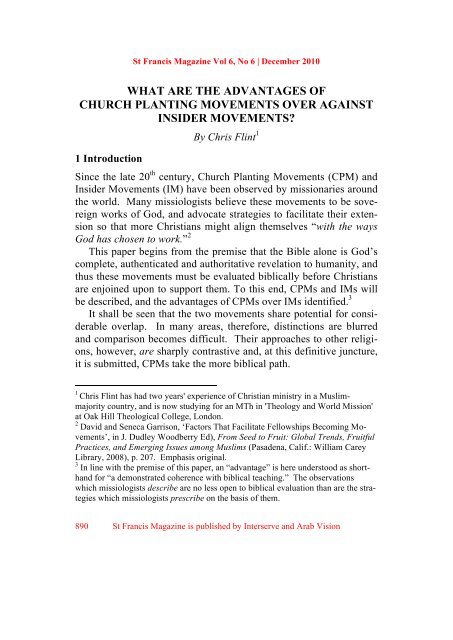

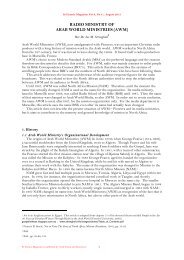
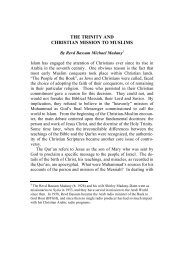
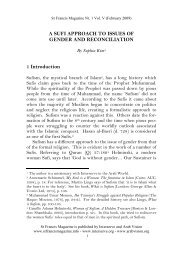
![Reflections on Surah Fatiha and the Lord's Prayer[1] - St.Francis ...](https://img.yumpu.com/49377951/1/184x260/reflections-on-surah-fatiha-and-the-lords-prayer1-stfrancis-.jpg?quality=85)
